Contents
Propagating barberry cuttings in the fall is very simple. With only 1 shrub, in a few years you can get a lot of planting material that will retain all the maternal qualities.
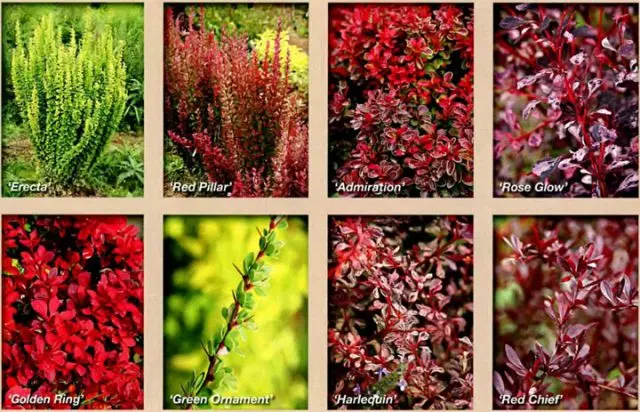
How barberry breeds
The barberry shrub is distinguished by its decorative effect and tasty berries. It is planted as a hedge and to attract bees to the site. The desire of gardeners to independently reproduce barberry is quite understandable, especially since it is not at all difficult.
Wild barberry bushes reproduce perfectly by self-sowing, and after a few years they completely fill the site. For cultivated forms, there are several main ways:
- obtaining root shoots;
- bends;
- cuttings.
In addition, ornamental shrubs are propagated by seeds, but this is the most complex method that requires knowledge and skills.
How to propagate barberry cuttings
Barberry cuttings can be carried out in summer, autumn or spring. However, green shoots cut at the beginning of the season take root better than others. The survival rate of planting material is almost 100%.
Lignified cuttings are cut in early spring before the buds swell or after leaf fall. Rooting them is not so easy, the survival rate is 85-90%. However, the advantages of such cuttings are obvious – the shoots grow quickly, in the future they bloom profusely and bear fruit.
In addition, this method of reproduction makes it possible to obtain planting material that completely retains all the varietal characteristics of the mother plant. For hybrid forms of shrubs, this is the best fit.
How to propagate barberry cuttings in summer
Planting material for propagation is cut from completely healthy bushes that grow and develop well. This is the only way to get high-quality seedlings that will give a noticeable annual increase and tasty berries.
Reproduction of barberry is possible by cuttings from the shoots of the current year, which are cut at the beginning of summer. The branch is ready for cuttings if the bark on it is light green.
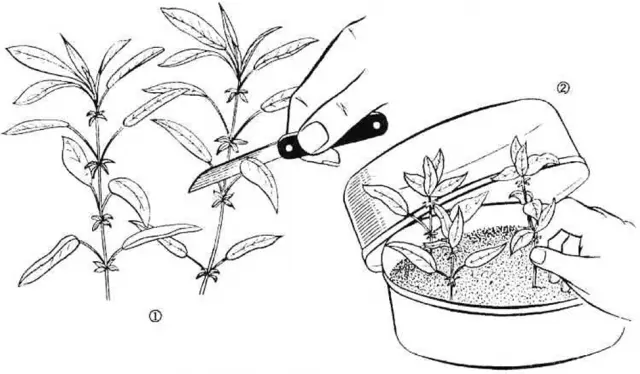
Landing Instructions:
- Planting material is harvested from the middle of the shoot. A good stalk is no more than 10 cm long and has 2-3 internodes.
- The lower cut is made directly under the kidney, and the upper edge is cut off 2 cm above.
- The upper leaves are shortened so that they do not evaporate moisture, and the lower leaves are completely removed.
- For reproduction, prepared shoots are planted in a greenhouse or boxes for rooting. The lower edge is dusted with Kornevin powder or another growth stimulant.
- Deepen shoots by 2 buds. Landing is done obliquely, at an angle of 45 °.
Rooting takes from 1 to 1,5 months. All this time, plantings need to be properly looked after: maintain soil moisture, temperature and create diffused lighting.
When new leaves appear on the shoots, one can judge the success of reproduction. Further care of young plants includes regular watering, weeding and top dressing. By autumn, full-fledged seedlings grow from the shoots, which are ready for transplanting into the garden next spring. Young bushes overwinter under good shelter, since their root system is still not sufficiently developed.
Propagation of barberry cuttings in autumn
Experienced gardeners practice barberry propagation at home with lignified cuttings. They are cut in autumn and stored until spring in the basement, where the temperature does not drop below +5°C. So that the planting material does not deteriorate, it is wrapped in a wet cloth, if necessary, additionally moistened. The cuttings are cut from the shoots left after pruning the shrub. Choose healthy branches that are not affected by diseases and pests, the diameter of which is not more than 1 cm.
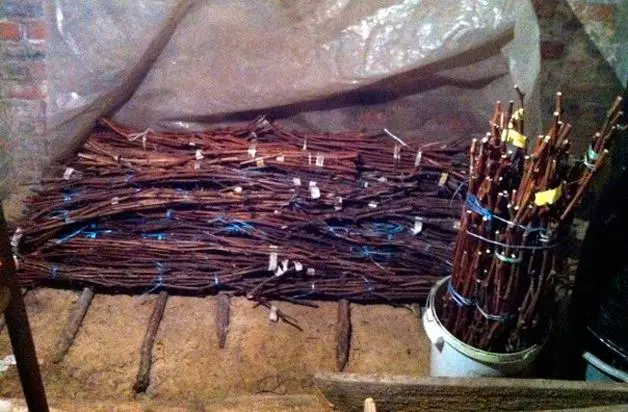
In the spring, planting material is taken out, inspected, dry shoots are discarded, planted on a prepared garden bed or in glasses. The soil will need loose, moisture-intensive, nutritious. Suitable store soil for seedlings or garden soil, which is enriched with humus, peat, loosened with sand.
Instructions for breeding in glasses:
- Prepare containers in advance: wash, disinfect, dry.
- Make drainage holes at the bottom, fill a third of the container with expanded clay or other material.
- Pour the soil into glasses so that 1,5-2 cm remains to the top. Water well.
- Deepen the cuttings by 2 buds into the ground, tamp around, water.
Cover the containers with a bag to create a greenhouse effect, but open every day for ventilation. If this is not done, then the cuttings will rot. After 1,5 months, young leaves will appear from the buds, completely remove the package. Further, barberry seedlings are planted on a garden bed, where they will grow up.
After grafting and successful rooting, barberry seedlings are transferred to a permanent place in the fall in the 2nd year of cultivation. For the winter, young bushes must cover.
Propagation of barberry cuttings in spring
If there is nowhere to save the shoots until spring, then for reproduction they are cut in early spring, until the buds swell. They get along worse. Before planting, barberry cuttings must be kept in water with a growth stimulator for 6-8 hours.
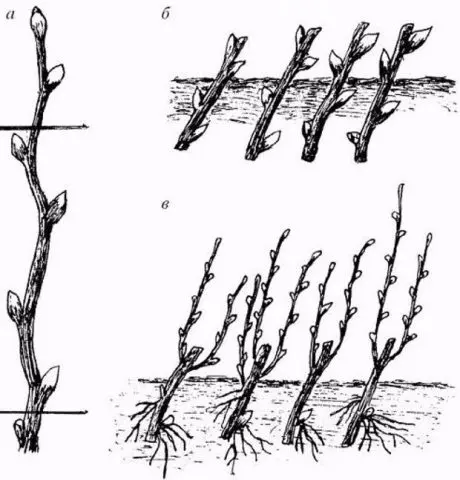
Planting material is rooted right in the garden. They are planted obliquely, 15-20 cm are left between the shoots. The soil is watered abundantly, mulched and covered with a film. Roots are formed in 1-1,5 months. From time to time the greenhouse is ventilated. When young leaves appear, the film is removed, the seedlings are well looked after. During the period of active growth, they are fed with nitrogen fertilizers or organic matter. A year later, they are transferred to a permanent place.
How to propagate barberry seeds
Barberry can be propagated in order to breed a new variety by seeds. This is a long process, its success depends on compliance with all the rules and experience of the gardener.
Planting material for propagation is obtained from overripe berries, washed and dried well. Before planting, the seeds are stored in paper bags with holes at room temperature. They have a short shelf life, so planting is best done in the same year. It is necessary to start sowing when the temperature outside drops below -2 ° C.
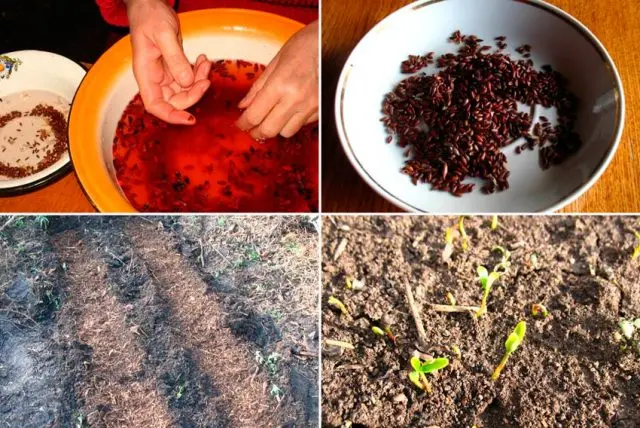
Barberry seeds are planted immediately in open ground. It is best to do this in the fall of the same year, so that they go through a natural stratification.
Landing recommendations:
- A bright area is allocated for planting, where the soil will warm up well in early spring.
- The grooves are made shallow, no more than 1-3 cm. So that the seeds do not rot, the holes are covered with coarse sand.
- Sowing is done sparsely, sprinkled on top with fertile soil and coniferous litter.
- In early spring, the shelter is removed, the bed is covered with a film so that friendly shoots appear.
Germination of barberry seeds is about 50%, so you need to sow more. Sprouts appear tight, develop slowly. In the phase of 2 true leaves, the bed is thinned out, leaving only strong plants. The distance between them is left at least 5 cm. Seedlings are transplanted to a permanent place after 2 years of cultivation.
Wild barberry bushes reproduce by self-seeding. Shoots appear in early spring, in the fall they can be dug up and transplanted to a new place. Such plants bear fruit with small berries, sweet and sour taste. However, they do not need special care, so beginners in gardening prefer this method of reproduction.
How to propagate barberry by layering
If there is a decorative barberry on the site, then it can be easily propagated by layering. The procedure is started in the spring in order to get full-fledged seedlings by the fall:
- For diversion, one-year-old shoots are chosen that bend well.
- Grooves are made around the mother bush, the branches are carefully laid in them, pinned and covered with earth. The tip of the shoot remains on the surface.
- The soil around the barberry is constantly kept moist so that root formation is successful.
In the fall of this year or next spring, young seedlings are dug up and transferred to the garden. By now they should have a good root system. Plants are placed in a well-lit area. The first few years, seedlings are insulated for the winter.
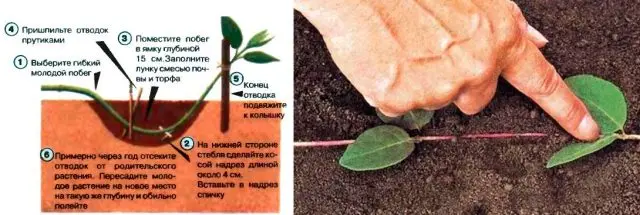
How to propagate barberry root shoots
The easiest way to propagate barberry is to transplant root shoots. In spring or early summer, green growth appears around the bush, which is carefully dug up and planted. Plants take root well, by the autumn they form full-fledged seedlings, which in a few years will please with a full-fledged harvest.
Reproduction of barberry by shoots allows you to get planting material with exactly the same characteristics as the mother bush. However, not all varieties produce many sprouts, most hybrid varieties do not form shoots at all.

The nuances of breeding barberry Thunberg
Barberry Thunberg is the most beautiful ornamental plant with an unusual leaf color. Bushes with golden yellow, orange or purple leaves decorate the site from early spring to late autumn. Plant height can be from 20 cm to 1,5 m. Barberry bears fruit with edible sour berries.
Reproduction of Thunberg barberry is not much different from other varieties; in summer it is easy to propagate shrubs with cuttings. To do this, use the green parts of the shoots, which are planted in a greenhouse. After rooting, the film is removed. The seedlings are fully cared for, and a year later they are planted in a permanent place.
In order to guarantee the transfer of all varietal characteristics from the mother plant to the young bush, barberry is propagated by grafting. It is made in early spring. A cutting is grafted onto a wild barberry, which has good winter hardiness.
Instructions:
- As a scion, a semi-woody cutting with a piece of bark is taken.
- A T-shaped incision is made on the rootstock directly around the kidney.
- The bark is gently pushed aside and the scion is inserted there.
- The grafting site is well fixed with a special film and covered with garden pitch.
After a few months, you can judge the success of the vaccination. Young leaves should appear on the cutting of the barberry. If this is not the case, then you need to check the vaccination site.
There is another way to propagate Thunberg barberry – grafting with an eye. From the plant you like, cut off the kidney along with a piece of bark. Further, it is grafted in the same way as a cutting. The only difference is that seedlings will develop slowly.

How to propagate barberry by dividing the bush
Reproduction of barberry by dividing the bush is not an easy procedure. The plant does not tolerate transplanting to a new place, it gets sick for a long time and may die. Reproduction is started in early spring or autumn, but only as a last resort. For example, if adult bushes still have to be dug up and planted, since they were originally planted in the wrong place.
Transplant instructions:
- Cut the barberry shoots at a height of 25-30 cm.
- The bushes are completely dug up and divided into sections with a sharp tool.
- Plant delenki in prepared holes.
- Cut shoots to a height of 15-20 cm.
After planting, young plants need to be well looked after. The soil is kept moist so that the bushes take root quickly.
Conclusion
It is quite possible to propagate barberry by cuttings in the fall, but all the nuances and subtleties of the process must be taken into account. In order for the shoots to take root successfully and bloom and bear fruit profusely in the future, it is important to properly care for the plants at each stage of growth.









